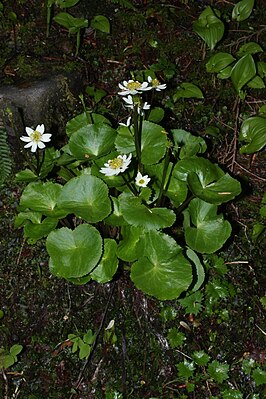West American marigold
| West American marigold | ||||||||||||
|---|---|---|---|---|---|---|---|---|---|---|---|---|

West American marigold ( Caltha leptosepala ) |
||||||||||||
| Systematics | ||||||||||||
|
||||||||||||
| Scientific name | ||||||||||||
| Caltha leptosepala | ||||||||||||
| DC. |
The West American marigold ( Caltha leptosepala ) is a species of the buttercup family (Ranunculaceae).
features
The West American marigold is a perennial herbaceous plant that reaches heights of up to 30 centimeters. The leaf blade is often longer than it is wide. The flower stem has no or only one leaf. The inflorescence consists of 1 to 2 (rarely 4) flowers . The bracts are mostly white, rarely yellow (with a bluish underside).
The flowering period extends from May to August.
The number of chromosomes is 2n = 48 or 96.
Occurrence
The West American marigold occurs in warm to cool North America in subalpine and alpine swamps and moist meadows at altitudes of 750 to 3900 meters.
use
The West American marigold is rarely used as an ornamental plant for pond edges. The species has been in culture since 1827 at the latest.
literature
- Eckehart J. Jäger, Friedrich Ebel, Peter Hanelt, Gerd K. Müller (eds.): Rothmaler excursion flora from Germany. Volume 5: Herbaceous ornamental and useful plants . Spectrum Academic Publishing House, Berlin Heidelberg 2008, ISBN 978-3-8274-0918-8 .